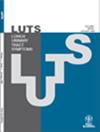Factors related to nocturia-specific quality of life in renal transplantation patients
Abstract
Objectives
Patients following renal transplantation (RTX) may experience nocturia exacerbation due to polyuria and reduced bladder capacity, thereby impacting the specific quality of life (QOL) associated with nocturia. The present study aims to investigate factors associated with the deterioration of nocturia-specific QOL in RTX patients.
Methods
The study cohort comprised 59 consecutive patients who had undergone successful RTX. Nocturia-related QOL questionnaires (N-QOL) were employed to evaluate the specific QOL related to nocturia. The Bother/Concern and Sleep/Energy domains of the N-QOL were also assessed. The primary outcome measure was to explore factors related to the aggravation of nocturia-specific QOL in patients post-RTX.
Results
The mean nocturia frequency post-RTX was 1.3 ± 1.0. Univariate and multivariate analyses revealed a significant reduction in the Bother/Concern domain score associated with increased nocturia (p = .042). Aging significantly decreased the total N-QOL score and the Sleep/Energy domain score (p = .001 and .0002, respectively). Prolonged duration after RTX significantly reduced the scores of both the Sleep/Energy domain and the Bother/Concern domain (p = .018 and .037, respectively). However, the duration of dialysis prior to RTX was not significantly associated with the total score or subdomains of N-QOL.
Conclusions
Nocturia-specific QOL affected not only the nocturia itself, but also aging and the prolonged duration after RTX. Thus, comprehensive approaches to the RTX patients were needed to improve the Nocturia-specific QOL in RTX patients.

 求助内容:
求助内容: 应助结果提醒方式:
应助结果提醒方式:


